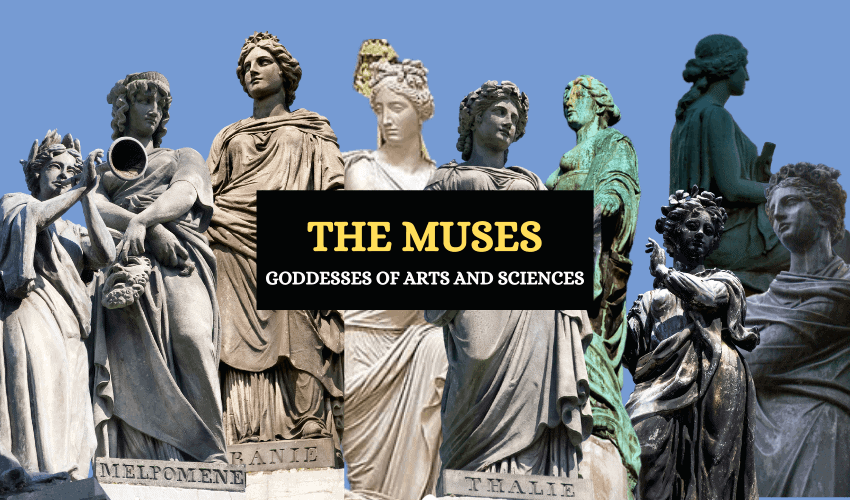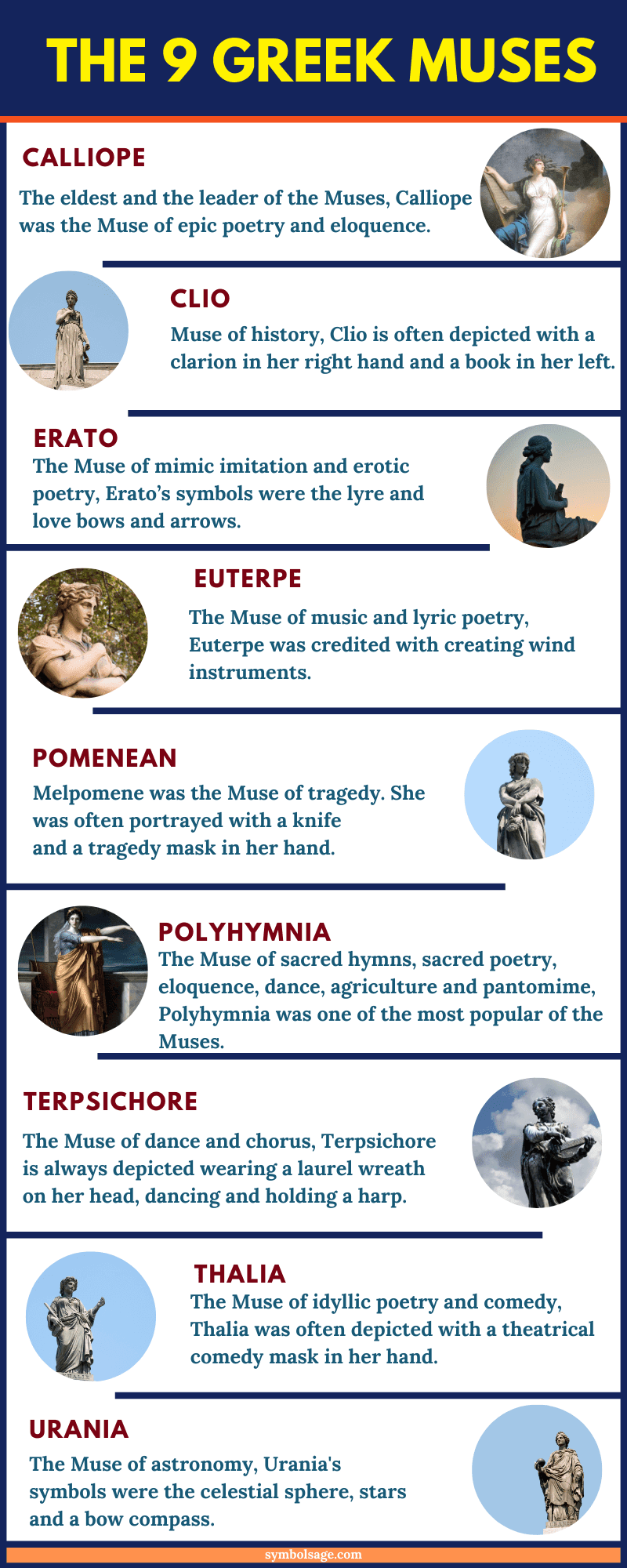
Table of Contents
The Nine Muses were minor goddesses of Greek mythology, who were closely linked to the arts and sciences. They guided and inspired mortals in their creation of literature, music, drama and other artistic and scientific ventures. The Muses rarely featured in any major myths of their own, but they were often invoked and remained among the most important of the Greek pantheon of deities.
The Origins of the Nine Greek Muses
The Muses were born to the Olympian god, Zeus, and the Titanness of memory, Mnemosyne. According to the myth, Zeus desired Mnemosyne and visited her often. Zeus slept with her for nine consecutive nights, and Mnemosyne delivered a daughter each night.
The girls collectively became known as the Younger Muses. This was so that they could be easily distinguished from the Elder Muses, the ancient Titan goddesses of music. Each of the muses ruled over a particular element of the arts and sciences, offering inspiration in her specific subject.

- Calliope – The eldest of them all, Calliope was the Muse of epic poetry and eloquence. She was said to have had the most beautiful voice of all the Muses. Calliope is usually seen holding laurels and two Homeric poems. She was considered the leader of the Muses.
- Clio – Clio was the Muse of history, or as stated in some accounts, she was the muse of lyre playing. She’s often depicted with a clarion in her right arm and a book in her left hand.
- Erato – The goddess of mimic imitation and erotic poetry, Erato’s symbols were the lyre and love bows and arrows.
- Euterpe – The Muse of lyric poetry and music, Euterpe was credited with creating wind instruments. Her symbols included the flute and panpipes, but she was often portrayed with many other instruments around her.
- Melpomene –Melpomene was the Muse of tragedy. She was often portrayed with a knife and a tragedy mask.
- Polyhymnia – The Muse of sacred hymns, sacred poetry, eloquence, dance, agriculture and pantomime, Polyhymnia was one of the most popular of the Muses. Her name means many (poly) and praise (hymns).
- Terpsichore – The Muse of dance and chorus, and in some versions a Muse of flute playing. Terpsichore is said to be the most well-known of the Muses, with her name in the English dictionary defined as an adjective meaning ‘pertaining to dancing’. She’s always depicted wearing a laurel wreath on her head, dancing and holding a harp.
- Thalia – The Muse of idyllic poetry and comedy, also known as the protector of Symposiums, Thalia was often depicted with a theatrical-comedy mask in her hand.
- Urania – The Muse of astronomy, Urania’s symbols were the celestial sphere, stars and a bow compass.
Apollo and the Nine Muses

Some sources say that when the Younger Muses were still children, their mother, Mnemosyne, gave them to Apollo, the god of music, and the Nymph Eufime. Apollo himself tutored them in the arts and when they grew up, they realized that nothing in regular human life interested them. They wished to dedicate their whole lives to the arts, with each having her own specialty.
Apollo brought the goddesses to Mount Elikonas, upon which an old temple of Zeus once stood. Since then, the Muses’ role was to encourage and support artists while enhancing their imagination and inspiring them in their work.
Hesiod and the Muses
Hesiod claims that the Muses visited him once when he was pasturing sheep on Mount Helicon. They gave him the gift of poetry and writing, which inspired him to write most of his later works. The Muses gifted him with a laurel staff which was symbolic of poetic authority.
In Hesiod’s Theogony, which turned out to be the most famous of his works, he describes the genealogy of the gods. He states that this information was given to him directly by the nine Muses at their meeting. The first section of the poem contains praise of the Muses and is dedicated to the nine goddesses.
The Role of the Nine Younger Muses
Some say that Zeus and Mnemosyne created the Nine Muses to celebrate the Olympian gods’ victory over the Titans as well as to forget all the terrible evils of the world. Their beauty, lovely voices and dancing helped relieve others’ sorrows.
The Muses spent a great deal of their time with the other Olympian gods, especially with Dionysus and Apollo. According to various sources, they were mostly to be found on Mount Olympus, seated near their father, Zeus. They were always welcome whenever there was a feast or a celebration and they would often entertain guests by singing and dancing.
They attended the weddings of Cadmus and Harmonia, Peleus and Thetis and Eros and Psyche. They also appeared at funerals of famous heroes like Achilles and his friend Patroclus. As they sang lamentations at these funerals, they also ensured that the greatness of the deceased individual would always be remembered and that those who mourned didn’t stay forever in sadness.
Although the Muses were lovely and kind goddesses, they also had their vengeful side, just like most of the deities of the Olympian pantheon. They were generally thought to be the best performers and they didn’t like it when anyone challenged their position. However, this happened quite often.
Many held contests against the Muses to see who the better performers were . The Muses were always victorious. However, they made sure to punish their opponents like Thamyris, the Sirens and the Pierides for going against them. They took away Thamyris’ skills, plucked off the feathers of the Sirens and transformed the female Pierides into birds.
Cult and Worship of the Nine Muses
In Greece, praying to the Younger Muses was a common practice by those who believed that their minds would be inspired and their work would be filled with divine skill and energy. Even Homer claims to have done the same while working on both the Odyssey and Iliad.
There were several shrines and temples throughout ancient Greece that were dedicated to the Muses. The two main centres were Mount Helicon, Boiotia and Peria located in Macedonia. Mount Helicon became location associated with the worship of these goddesses.
The Muses in Arts
The Nine Muses have been mentioned in numerous paintings, plays, poems and statues. They’re among the most famous characters of Greek mythology, implying the extent to which arts and sciences were held in high-esteem by the ancient Greeks. Many of the ancient Greek writers, such as Hesiod and Homer, invoked the Muses, asking for inspiration and assistance.
To the Muses
Whether on Ida’s shady brow,
Or in the chambers of the East,
The chambers of the sun, that now
From ancient melody have ceas’d;
Whether in Heav’n ye wander fair,
Or the green corners of the earth,
Or the blue regions of the air,
Where the melodious winds have birth;
Whether on crystal rocks ye rove,
Beneath the bosom of the sea
Wand’ring in many a coral grove,
Fair Nine, forsaking Poetry!
How have you left the ancient love
That bards of old enjoy’d in you!
The languid strings do scarcely move!
The sound is forc’d, the notes are few!
BY WILLIAM BLAKE
In Brief
The Muses were credited with inspiring some of the greatest art, poetry and music created by mortal men and women throughout history. As minor goddesses of the Greek pantheon, they hardly ever featured in their own myths individually. Instead, they tended to appear as background characters, supplementing, supporting and assisting the main characters of the myths. Today many people continue to remember the Muses as the guides and inspirers of creation and some artists still believe that their skills were inspired by them.








